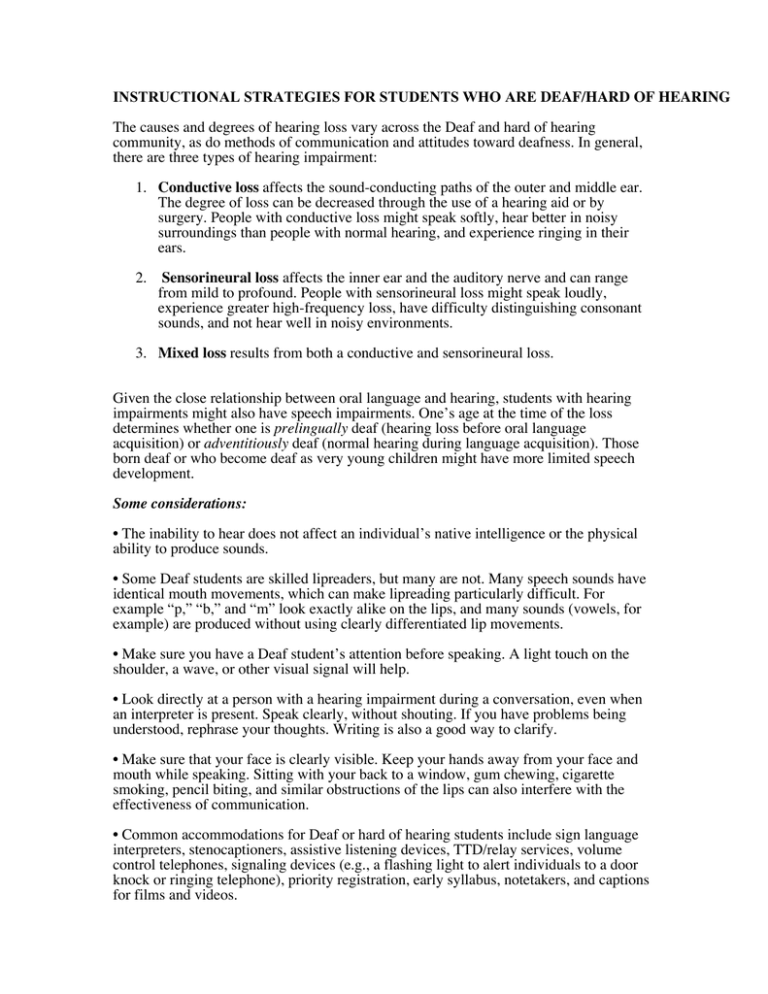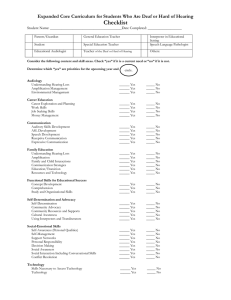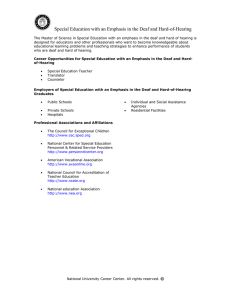Instructional Strategies for students who are Deaf
advertisement

INSTRUCTIONAL STRATEGIES FOR STUDENTS WHO ARE DEAF/HARD OF HEARING The causes and degrees of hearing loss vary across the Deaf and hard of hearing community, as do methods of communication and attitudes toward deafness. In general, there are three types of hearing impairment: 1. Conductive loss affects the sound-conducting paths of the outer and middle ear. The degree of loss can be decreased through the use of a hearing aid or by surgery. People with conductive loss might speak softly, hear better in noisy surroundings than people with normal hearing, and experience ringing in their ears. 2. Sensorineural loss affects the inner ear and the auditory nerve and can range from mild to profound. People with sensorineural loss might speak loudly, experience greater high-frequency loss, have difficulty distinguishing consonant sounds, and not hear well in noisy environments. 3. Mixed loss results from both a conductive and sensorineural loss. Given the close relationship between oral language and hearing, students with hearing impairments might also have speech impairments. One’s age at the time of the loss determines whether one is prelingually deaf (hearing loss before oral language acquisition) or adventitiously deaf (normal hearing during language acquisition). Those born deaf or who become deaf as very young children might have more limited speech development. Some considerations: • The inability to hear does not affect an individual’s native intelligence or the physical ability to produce sounds. • Some Deaf students are skilled lipreaders, but many are not. Many speech sounds have identical mouth movements, which can make lipreading particularly difficult. For example “p,” “b,” and “m” look exactly alike on the lips, and many sounds (vowels, for example) are produced without using clearly differentiated lip movements. • Make sure you have a Deaf student’s attention before speaking. A light touch on the shoulder, a wave, or other visual signal will help. • Look directly at a person with a hearing impairment during a conversation, even when an interpreter is present. Speak clearly, without shouting. If you have problems being understood, rephrase your thoughts. Writing is also a good way to clarify. • Make sure that your face is clearly visible. Keep your hands away from your face and mouth while speaking. Sitting with your back to a window, gum chewing, cigarette smoking, pencil biting, and similar obstructions of the lips can also interfere with the effectiveness of communication. • Common accommodations for Deaf or hard of hearing students include sign language interpreters, stenocaptioners, assistive listening devices, TTD/relay services, volume control telephones, signaling devices (e.g., a flashing light to alert individuals to a door knock or ringing telephone), priority registration, early syllabus, notetakers, and captions for films and videos. Modes of Communication Not all Deaf students are fluent users of all of the communication modes used across the Deaf community, just as users of spoken language are not fluent in all oral languages. For example, not all Deaf students lipread; many use sign language, but there are several types of sign language systems. American Sign Language (ASL) is a natural, visual language having its own syntax and grammatical structure. Fingerspelling is the use of the manual alphabet to form words. Pidgin Sign English (PSE) combines aspects of ASL and English and is used in educational situations often combined with speech. Nearly every spoken language has an accompanying sign language. It is important to assign interpreters who will match the communication needs and preferences of each student. Interpreters convey all information in a given situation, including instructor’s comments, class discussion, and environmental sounds. Instructional Strategies The following strategies are suggested in order to enhance the accessibility of course instruction, materials, and activities. They are general strategies designed to support individualized reasonable accommodations for which a student is eligible, as determined by the Office of Student Life. • Circular seating arrangements offer Deaf or hard of hearing students the advantage of seeing all class participants, especially in a seminar setting. • For the lecture setting, keep front seats open for students who are Deaf or hard of hearing and their interpreters. • Repeat the comments and questions of other students, especially those from the back rows; acknowledge who has made the comment so the Deaf or hard of hearing student can focus on the speaker. • When appropriate, ask for a hearing volunteer to team up with a Deaf or hard of hearing student for in-class assignments. • On request from the student, assist with finding an effective notetaker or lab assistant from the class. • If possible, provide transcripts of audio information. • Face the class while speaking; if an interpreter is present, make sure the student can see both you and the interpreter. • Because visual information is a Deaf student’s primary means of receiving information, films, overheads, diagrams, and other visual aids are useful instructional tools. Spoken dialogue and commentary in films, videotapes, DVDs, and online course websites, should either be presented in captions or other alternate means such as a transcript. • Be flexible: allow a Deaf student to work with audiovisual material independently and for a longer period of time. • When in doubt about how to assist the student, ask him or her. • Allow the student the same anonymity as other students (i.e., avoid pointing out the student or the alternative arrangements to the rest of the class).


